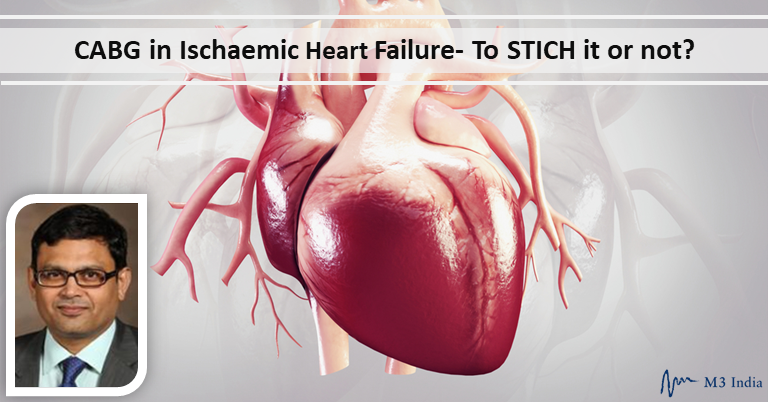CABG in Ischaemic Heart Failure- 'To STICH it or not, that is the question!': Prof. Dr. Sundeep Mishra
M3 India Newsdesk Jul 17, 2019
Prof. Dr. Sundeep Mishra critically analyses the STICH trial which showed the long-term benefit of CABG in terms of lowering the overall mortality from any cause in patients of ischaemic cardiomyopathy.

Coronary artery bypass grafting (CABG) is a reasonable alternative in patients with manifest coronary artery disease (CAD) especially if symptomatic despite optimal medical therapy (OMT). However, CABG by virtue of being an invasive procedure carries certain amount of risk which increases with complexity of disease, severity of left ventricular dysfunction or associated co-morbidities.
It is thus a big question whether it can be effectively performed with acceptable mortality for most patients with ischaemic cardiomyopathy especially with manifest heart failure. These patients really are a heterogeneous group, differing markedly in terms of age, co-morbidities, functional class, and ejection fraction.
Is CABG the answer for ischaemic cardiomyopathy patients?- Prof. Mishra opines
In this context STICH (Surgical Treatment for Ischaemic Heart Failure) was on the face of it a negative trial showing no mortality benefit (primary end-point) of CABG in patients with ischaemic cardiomyopathy. However, it did show some benefit in terms of secondary end-point of cardiovascular mortality and death + cardiovascular hospitalisation over a follow-up period of 56 months. Furthermore, there is the expectation of benefit in a patient of ischaemic cardiomyopathy with preserved myocardial viability.
- Medical therapy in patients with ischaemic cardiomyopathy who demonstrate viability is better than those without, but whether surgery is better than medical therapy in this group is not well established. STICH trial also provides no evidence of benefit of surgery in patients with myocardial viability.
- Another issue is severity of left ventricular dysfunction were although efficacy may be similar, the surgical risks are clearly different. Certainly surgical outcome for a patient with an ejection fraction of 35% is much different from those with an ejection fraction of 10% or even 5%. Thus, at extreme levels of left ventricular dysfunction, CABG should be performed by surgeons in high-volume centres who are used to dealing with complex patients, and where access to pharmacologic and mechanical means of treating low cardiac output syndrome is available. In some patients with advanced disease, there could be even a requirement of left ventricular assist device.
- Furthermore, meticulous attention also needs to be paid to myocardial protection delivered ideally, both antegradely and retrogradely. Indeed some patients may even be contraindicated because of low cardiac output to begin with (and thus inability to tolerate cardiopulmonary bypass).
- Finally, there is an issue of cost. Any surgical procedure entails a certain cost not only in terms of procedure but also subsequent hospitalisation. Furthermore, heart failure patients are already sicker, requiring more equipment intra-procedure and more ICU stay post-operatively. In particular those patients with markedly reduced left ventricular function with/without low cardiac output may require a cardiac assist device which may increase the cost manifold.
Thus, inferences from STICH as to the appropriateness of CABG for patients with ischaemic cardiomyopathy must be drawn cautiously. Some patients may indeed benefit from surgical option but as with all medical and surgical therapies, treatment has to be individualised to the patient.
If offered surgery, frank preoperative discussions should be undertaken with the patient and their family about the risks and likelihood of needing advanced therapies postoperatively. Although the need for such therapies is rare, it is easier to have had the discussion should the need arise.
Disclaimer- The views and opinions expressed in this article are those of the author's and do not necessarily reflect the official policy or position of M3 India.
The writer, Dr. Sundeep Mishra is a Professor of Cardiology.
-
Exclusive Write-ups & Webinars by KOLs
-
Daily Quiz by specialty
-
Paid Market Research Surveys
-
Case discussions, News & Journals' summaries